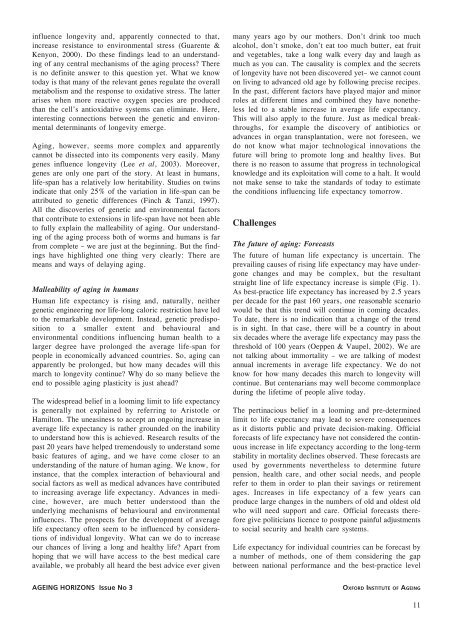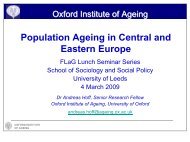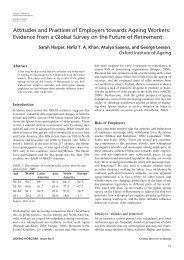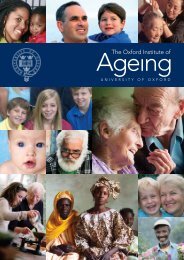Broken limits to life expectancy - by Vaupel and v.Kistowksi
Broken limits to life expectancy - by Vaupel and v.Kistowksi
Broken limits to life expectancy - by Vaupel and v.Kistowksi
Create successful ePaper yourself
Turn your PDF publications into a flip-book with our unique Google optimized e-Paper software.
influence longevity <strong>and</strong>, apparently connected <strong>to</strong> that,<br />
increase resistance <strong>to</strong> environmental stress (Guarente &<br />
Kenyon, 2000). Do these findings lead <strong>to</strong> an underst<strong>and</strong>ing<br />
of any central mechanisms of the aging process? There<br />
is no definite answer <strong>to</strong> this question yet. What we know<br />
<strong>to</strong>day is that many of the relevant genes regulate the overall<br />
metabolism <strong>and</strong> the response <strong>to</strong> oxidative stress. The latter<br />
arises when more reactive oxygen species are produced<br />
than the cell’s antioxidative systems can eliminate. Here,<br />
interesting connections between the genetic <strong>and</strong> environmental<br />
determinants of longevity emerge.<br />
Aging, however, seems more complex <strong>and</strong> apparently<br />
cannot be dissected in<strong>to</strong> its components very easily. Many<br />
genes influence longevity (Lee et al, 2003). Moreover,<br />
genes are only one part of the s<strong>to</strong>ry. At least in humans,<br />
<strong>life</strong>-span has a relatively low heritability. Studies on twins<br />
indicate that only 25% of the variation in <strong>life</strong>-span can be<br />
attributed <strong>to</strong> genetic differences (Finch & Tanzi, 1997).<br />
All the discoveries of genetic <strong>and</strong> environmental fac<strong>to</strong>rs<br />
that contribute <strong>to</strong> extensions in <strong>life</strong>-span have not been able<br />
<strong>to</strong> fully explain the malleability of aging. Our underst<strong>and</strong>ing<br />
of the aging process both of worms <strong>and</strong> humans is far<br />
from complete – we are just at the beginning. But the findings<br />
have highlighted one thing very clearly: There are<br />
means <strong>and</strong> ways of delaying aging.<br />
Malleability of aging in humans<br />
Human <strong>life</strong> <strong>expectancy</strong> is rising <strong>and</strong>, naturally, neither<br />
genetic engineering nor <strong>life</strong>-long caloric restriction have led<br />
<strong>to</strong> the remarkable development. Instead, genetic predisposition<br />
<strong>to</strong> a smaller extent <strong>and</strong> behavioural <strong>and</strong><br />
environmental conditions influencing human health <strong>to</strong> a<br />
larger degree have prolonged the average <strong>life</strong>-span for<br />
people in economically advanced countries. So, aging can<br />
apparently be prolonged, but how many decades will this<br />
march <strong>to</strong> longevity continue? Why do so many believe the<br />
end <strong>to</strong> possible aging plasticity is just ahead?<br />
The widespread belief in a looming limit <strong>to</strong> <strong>life</strong> <strong>expectancy</strong><br />
is generally not explained <strong>by</strong> referring <strong>to</strong> Aris<strong>to</strong>tle or<br />
Hamil<strong>to</strong>n. The uneasiness <strong>to</strong> accept an ongoing increase in<br />
average <strong>life</strong> <strong>expectancy</strong> is rather grounded on the inability<br />
<strong>to</strong> underst<strong>and</strong> how this is achieved. Research results of the<br />
past 20 years have helped tremendously <strong>to</strong> underst<strong>and</strong> some<br />
basic features of aging, <strong>and</strong> we have come closer <strong>to</strong> an<br />
underst<strong>and</strong>ing of the nature of human aging. We know, for<br />
instance, that the complex interaction of behavioural <strong>and</strong><br />
social fac<strong>to</strong>rs as well as medical advances have contributed<br />
<strong>to</strong> increasing average <strong>life</strong> <strong>expectancy</strong>. Advances in medicine,<br />
however, are much better unders<strong>to</strong>od than the<br />
underlying mechanisms of behavioural <strong>and</strong> environmental<br />
influences. The prospects for the development of average<br />
<strong>life</strong> <strong>expectancy</strong> often seem <strong>to</strong> be influenced <strong>by</strong> considerations<br />
of individual longevity. What can we do <strong>to</strong> increase<br />
our chances of living a long <strong>and</strong> healthy <strong>life</strong>? Apart from<br />
hoping that we will have access <strong>to</strong> the best medical care<br />
available, we probably all heard the best advice ever given<br />
many years ago <strong>by</strong> our mothers. Don’t drink <strong>to</strong>o much<br />
alcohol, don’t smoke, don’t eat <strong>to</strong>o much butter, eat fruit<br />
<strong>and</strong> vegetables, take a long walk every day <strong>and</strong> laugh as<br />
much as you can. The causality is complex <strong>and</strong> the secrets<br />
of longevity have not been discovered yet– we cannot count<br />
on living <strong>to</strong> advanced old age <strong>by</strong> following precise recipes.<br />
In the past, different fac<strong>to</strong>rs have played major <strong>and</strong> minor<br />
roles at different times <strong>and</strong> combined they have nonetheless<br />
led <strong>to</strong> a stable increase in average <strong>life</strong> <strong>expectancy</strong>.<br />
This will also apply <strong>to</strong> the future. Just as medical breakthroughs,<br />
for example the discovery of antibiotics or<br />
advances in organ transplantation, were not foreseen, we<br />
do not know what major technological innovations the<br />
future will bring <strong>to</strong> promote long <strong>and</strong> healthy lives. But<br />
there is no reason <strong>to</strong> assume that progress in technological<br />
knowledge <strong>and</strong> its exploitation will come <strong>to</strong> a halt. It would<br />
not make sense <strong>to</strong> take the st<strong>and</strong>ards of <strong>to</strong>day <strong>to</strong> estimate<br />
the conditions influencing <strong>life</strong> <strong>expectancy</strong> <strong>to</strong>morrow.<br />
Challenges<br />
The future of aging: Forecasts<br />
The future of human <strong>life</strong> <strong>expectancy</strong> is uncertain. The<br />
prevailing causes of rising <strong>life</strong> <strong>expectancy</strong> may have undergone<br />
changes <strong>and</strong> may be complex, but the resultant<br />
straight line of <strong>life</strong> <strong>expectancy</strong> increase is simple (Fig. 1).<br />
As best-practice <strong>life</strong> <strong>expectancy</strong> has increased <strong>by</strong> 2.5 years<br />
per decade for the past 160 years, one reasonable scenario<br />
would be that this trend will continue in coming decades.<br />
To date, there is no indication that a change of the trend<br />
is in sight. In that case, there will be a country in about<br />
six decades where the average <strong>life</strong> <strong>expectancy</strong> may pass the<br />
threshold of 100 years (Oeppen & <strong>Vaupel</strong>, 2002). We are<br />
not talking about immortality – we are talking of modest<br />
annual increments in average <strong>life</strong> <strong>expectancy</strong>. We do not<br />
know for how many decades this march <strong>to</strong> longevity will<br />
continue. But centenarians may well become commonplace<br />
during the <strong>life</strong>time of people alive <strong>to</strong>day.<br />
The pertinacious belief in a looming <strong>and</strong> pre-determined<br />
limit <strong>to</strong> <strong>life</strong> <strong>expectancy</strong> may lead <strong>to</strong> severe consequences<br />
as it dis<strong>to</strong>rts public <strong>and</strong> private decision-making. Official<br />
forecasts of <strong>life</strong> <strong>expectancy</strong> have not considered the continuous<br />
increase in <strong>life</strong> <strong>expectancy</strong> according <strong>to</strong> the long-term<br />
stability in mortality declines observed. These forecasts are<br />
used <strong>by</strong> governments nevertheless <strong>to</strong> determine future<br />
pension, health care, <strong>and</strong> other social needs, <strong>and</strong> people<br />
refer <strong>to</strong> them in order <strong>to</strong> plan their savings or retirement<br />
ages. Increases in <strong>life</strong> <strong>expectancy</strong> of a few years can<br />
produce large changes in the numbers of old <strong>and</strong> oldest old<br />
who will need support <strong>and</strong> care. Official forecasts therefore<br />
give politicians licence <strong>to</strong> postpone painful adjustments<br />
<strong>to</strong> social security <strong>and</strong> health care systems.<br />
Life <strong>expectancy</strong> for individual countries can be forecast <strong>by</strong><br />
a number of methods, one of them considering the gap<br />
between national performance <strong>and</strong> the best-practice level<br />
AGEING HORIZONS Issue No 3<br />
OXFORD INSTITUTE OF AGEING<br />
11





![ORAL PRESENTATIONS [pdf] - Oxford Institute of Ageing](https://img.yumpu.com/37918222/1/184x260/oral-presentations-pdf-oxford-institute-of-ageing.jpg?quality=85)




